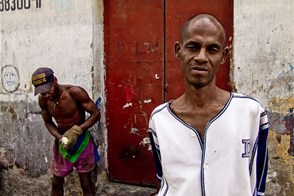A Colombian peasant scoops up hot sugar cane juice in a cooking pot during the processing of panela in a rural sugar cane mill (trapiche) in San Agustín, Colombia.

A Colombian peasant collects sugar cane stalks before processing of panela in a rural sugar cane mill (trapiche) in San Agustín, Colombia.

A Colombian peasant pours hot sugar cane juice into a wooden mold during the processing of panela in a rural sugar cane mill (trapiche) in San Agustín, Colombia.

A Colombian farmer Ramiro Burbano controls the processing of panela in a rural sugar cane mill (trapiche) in San Agustín, Colombia.

Colombian kids play on a pile of sugar cane stalks during the processing of panela in a rural sugar cane mill (trapiche) in San Agustín, Colombia.

A Colombian peasant works in the smoke of boiling sugar cane juice during the processing of panela in a rural sugar cane mill (trapiche) in San Agustín, Colombia.

Panela
San Agustín, Colombia – 18 April 2004
Panela, a solid block of raw, unrefined sugar, is made by cooking and evaporation of the sugar cane juice into a golden, sticky syrup which is then poured into the wooden molds and allowed to solidify. Having the taste like a cross between molasses and brown sugar, panela is served as a hot or cold infusion (aguapanela). Due to the large amounts of proteins, vitamins and minerals and thus, panela is believed to have healing powers. Cheaper than sugar, it is consumed by the majority of Colombians and it is a major source of calories for children from families with low socioeconomic status. With more than 70,000 farms that cultivate sugarcane for mills, panela production is an important economic activity in the Colombian countryside, employing around 350,000 people and being the second largest source of jobs after agricultural coffee production.









no comments yet